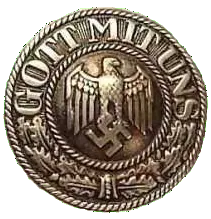Page 276
Black was also suggested--certainly well-suited to the times, but embodying no significance to empress the will behind our movement. And, finally, black is incapable of attracting attention.
White and blue was discarded, despite its admirable aesthetic appeal--as being the colours of an individual German Federal State--a State that, unfortunately, through its political attitude of particularist narrow-mindedness did not enjoy a good reputation. And, generally speaking, with these colours it would have been difficult to attract attention to our movement. The same applies to black and white.
Black, red and gold did not enter the question at all.
And this also applies to black, white and red for reasons already stated. At least, not in the form hitherto in use. But the effectiveness of these three colours is far superior to all the others and they are certainly the most strikingly harmonious combination to be found.
I myself was always for keeping the old colours, not only because I, as a soldier, regarded them as my most sacred possession, but because in their aesthetic effect, they conformed more than anything else to my personal taste. Accordingly I had to discard all the innumerable suggestions and designs which had been proposed for the new movement, among which were many that had incorporated the swastika into the old colours. I, as leader, was unwilling to make public my own design, as it was possible that someone else could come forward with a design just as good, if not better, than my own. As a matter of fact, a dental surgeon from Starnberg submitted a good design very similar to mine, with only one mistake, in that his swastika with curved corners was set upon a white background.
After innumerable trials I decided upon a final form--a flag of red material with a white disc bearing in its centre a black swastika. After many trials I obtained the correct proportions between the dimensions of the flag and of the white central disc, as well as that of the swastika. And this is how it has remained ever since.
At the same time we immediately ordered the corresponding armlets for our squad of men who kept order at meetings, armlets of red material, a central white disc with the black swastika upon it. Herr Füss, a Munich goldsmith, supplied the first practical and permanent design.
The new flag appeared in public in the midsummer of 1920. It suited our movement admirably, both being new and young. Not a soul had seen this flag before; its effect at that time was something akin to that of a blazing torch. We ourselves experienced almost a boyish delight when one of the ladies of the party who had been entrusted with the making of the flag finally handed it over to us. And a few months later those of us in Munich were in possession of six of these flags. The steadily increasing strength of our hall guards was a main factor in popularizing the symbol.
And indeed a symbol it proved to be.
Not only because it incorporated those revered colours expressive of our homage to the glorious past and which once brought so much honour to the German nation, but this symbol was also an eloquent expression of the will behind the movement. We National Socialists regarded our flag as being the embodiment of our party programme. The red expressed the social thought underlying the movement. White the national thought. And the swastika signified the mission allotted to us--the struggle for the victory of Aryan mankind and at the same time the triumph of the ideal of creative work which is in itself and always will be anti-Semitic.
Two years later, when our squad of hall guards had long since grown into storm detachments, it seemed necessary to give this defensive organization of a young Weltanschauung a particular symbol of victory, namely a Standard. I also designed this and entrusted the execution of it to an old party comrade, Herr Gahr, who was a goldsmith. Ever since that time this Standard has been the distinctive token of the National Socialist struggle.
The increasing interest taken in our meetings, particularly during 1920, com-


























